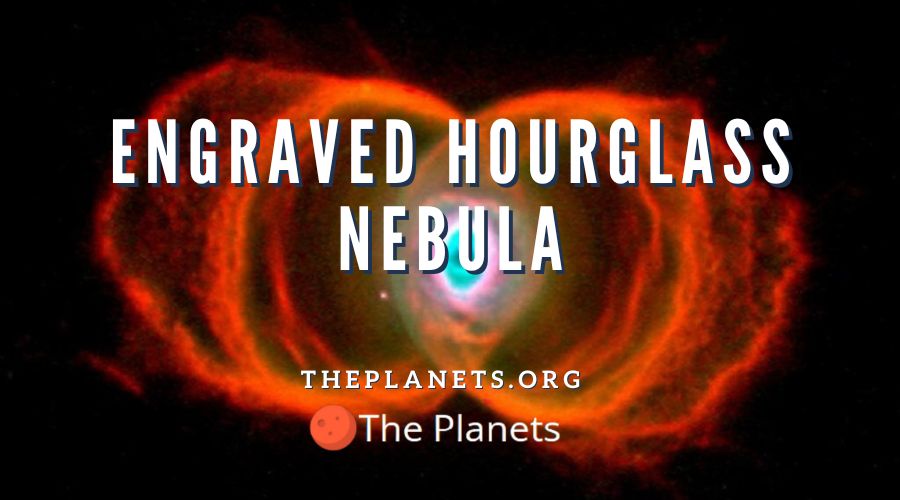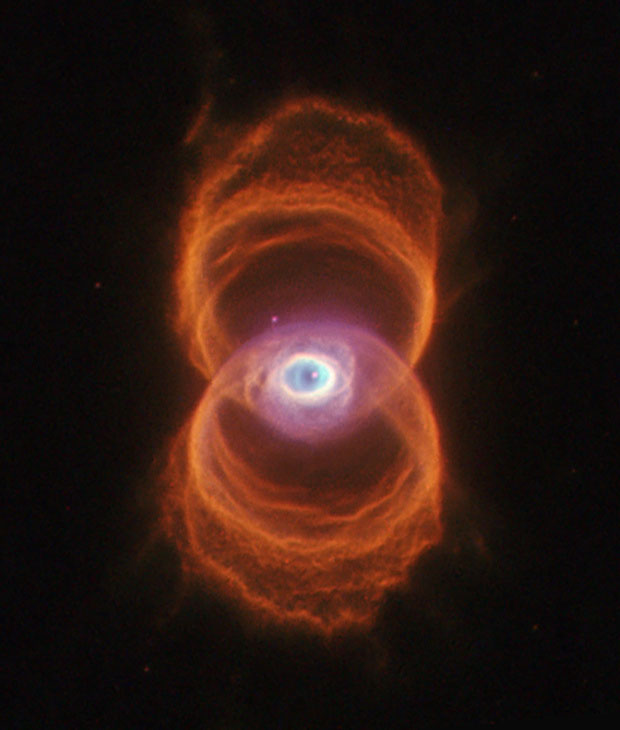
It can be seen in a small part of the northern hemisphere and all of the southern hemisphere in the small Musca constellation. Seeing this nebula requires a small telescope of about 5 inches in diameter or bigger.

Facts about the Engraved Hourglass Nebula
- The original and official name of the Engraved Hourglass Nebula is MyCn18.
- The original discoverers of the nebula did not know it was in the shape of an hourglass, because their telescopes were not powerful enough to see the whole shape.
- The hourglass shape was first discovered in 1996 by Raghvendra Sahal and John Trauger, almost 100 years after the nebula was first discovered.
- Most of the images we see of the Engraved Hourglass Nebula are not true color images but are instead manipulated so that different elements in the nebula, like Hydrogen, Oxygen, and Nitrogen, are displayed by different colors.
- The center star of the nebula is called the Wolf-Rayet star and is thought to have a temperature of 110,000 Kelvin, or 197,000 degrees Fahrenheit.
- The gases that make up the nebula are expanding away from the center star at a speed of 10 kilometers per second.
- Planetary nebula like the Engraved Hourglass Nebula don’t have anything to do with actual planets. The name “planetary nebula” comes from the round, planet-like appearance of these nebulae when observed in simple telescopes.
- All planetary nebulae, like the Engraved Hourglass Nebula, are formed by red giant stars at the end of their life. Our own sun will turn into a red giant star in about 5 billion years, and eventually into its own planetary nebula, maybe similar to the Engraved Hourglass Nebula.
- All planetary nebulae, like this nebula, are relatively short lived, lasting only tens of thousands of years. They are, however, very important in spreading elements across the galaxy.
- The Musca constellation, where the Engraved Hourglass Nebula is found, can only be observed at latitude less than 10 degrees north. This includes all of South America, most of Africa (except the Sahara Desert), all of Australia, a small part of southern India, and all of Indonesia, Malaysia, and the Polynesian islands.
- The hourglass shape of the nebula comes from complex forces of stellar winds and gravity that push and pull the different gases into the shapes we see.
- Other hourglass shaped nebulae have been found throughout the galaxy, suggesting that the forces that formed the nebula are common.
- Although the cause of the hourglass shape is well understood by scientists, other parts of the nebula are still a mystery, like its different rings and the detailed “etchings” that can be found when looking closely at the nebula.
- Some scientists believe the center of the hourglass nebula actually has two stars, one that caused the nebula to form, and another that continues to orbit around the center of the nebula.
- The Engraved Hourglass Nebula is about 8,000 light years away, meaning it takes light 8,000 years to reach us here on Earth. This means the version of the nebula we are seeing today is actually 8,000 years old.
- If you were to walk to the Engraved Hourglass Nebula it would take you about 1.3 trillion years to get there, or 7.3 billion years in an airplane.